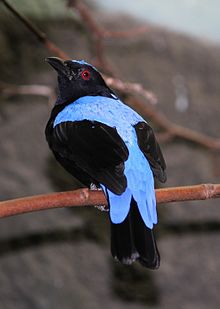Fairy-bluebird
| Fairy-bluebirds | |
|---|---|
 |
|
| Asian fairy-bluebird - male | |
 |
|
| female | |
| Scientific classification | |
| Kingdom: | Animalia |
| Phylum: | Chordata |
| Class: | Aves |
| Order: | Passeriformes |
| Suborder: | Passeri |
| Family: |
Irenidae Jerdon, 1863 |
| Genus: |
Irena Horsfield, 1821 |
 |
|
|
Irena puella light green, Irena cyanogaster dark green |
|
The two fairy-bluebirds are small passerine bird species found in forests and plantations in tropical southern Asia and the Philippines. They are the sole members of the genus Irena and family Irenidae, and are related to the ioras and leafbirds.
These are bulbul-like birds of open forest or thorn scrub, but whereas that group tends to be drab in colouration, fairy-bluebirds are sexually dimorphic, with the males being dark blue in plumage, and the females duller green.
These species eat fruit, especially figs, and possibly some insects. They lay two to three eggs in a tree nest.
The call of the Asian fairy-bluebird is a liquid two note Glue-It.
As the names would suggest, the Asian fairy-bluebird occurs across southern Asia, and the Philippine fairy-bluebird in that archipelago.
The first scientists to examine fairy-bluebirds placed them in the roller genus Coracias, presumably on the strength of the iridescent blue plumage on the back. This was challenged in the 1820s by Thomas Horsfield and Coenraad Temminck, who suggested a relationship instead with the drongos. It was variously placed with the bulbuls and orioles as well. On the basis of the DNA-DNA hybridization studies of Sibley and Alhquist its closest relatives have now been identified as the leafbirds. The leafbirds are sometimes included in the family Irenidae with the fairy-bluebirds, but the time since the apparent divergence suggests that they are better treated as separate families.
...
Wikipedia
